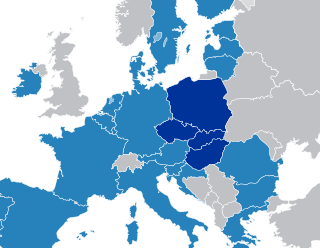
Gross Domestic Product (GDP) is a monetary measure of the market value of all the final goods and services produced and rendered in a specific time period by a country or countries. GDP is more often used by the government of a single country to measure its economic health. Due to its complex and subjective nature, this measure is often revised before being considered a reliable indicator.

The Visegrád Group is a cultural and political alliance of four Central European countries: the Czech Republic, Hungary, Poland, and Slovakia. The alliance aims to advance co-operation in military, economic, cultural and energy affairs, and to further their integration with the EU. All four states are also members of the European Union (EU), the North Atlantic Treaty Organization (NATO), and the Bucharest Nine (B9).

Western Greece Region is one of the thirteen administrative regions of Greece. It comprises the western part of continental Greece and the northwestern part of the Peloponnese peninsula. It occupies an area of 11,336 km2 (4,377 sq mi) and its population is, according to the 2011 census, at 679,796 inhabitants. The capital of the Western Greece is Patras, the third-largest-city in the country with a population of about 280,000 inhabitants. The NUTS 2 code for the region of Western Greece is EL63.

The Central Bohemian Region is an administrative unit of the Czech Republic, located in the central part of its historical region of Bohemia. Its administrative centre is in the Czech capital Prague, which lies in the centre of the region. However, the city is not part of it but is a region of its own.

Olomouc Region is an administrative unit of the Czech Republic, located in the north-western and central part of its historical region of Moravia (Morava) and in a small part of the historical region of Czech Silesia. It is named for its capital Olomouc.

The economy of Serbia is a service-based upper-middle income economy in the Central Europe, with the tertiary sector accounting for two-thirds of total gross domestic product (GDP). The economy functions on the principles of the free market. Nominal GDP in 2024 is projected to reach $81.873 billion, which is $12,385 per capita, while GDP based on purchasing power parity (PPP) stood at $185.014 billion, which is $27,985 per capita. The strongest sectors of Serbia's economy are energy, the automotive industry, machinery, mining, and agriculture. The country's primary industrial exports are automobiles, base metals, furniture, food processing, machinery, chemicals, sugar, tires, clothes, and pharmaceuticals. Trade plays a major role in Serbian economic output. The main trading partners are Germany, Italy, Russia, China, and neighbouring Balkan countries.
Gross regional domestic product (GRDP), gross domestic product of region (GDPR), or gross state product (GSP) is a statistic that measures the size of a region's economy. It is the aggregate of gross value added (GVA) of all resident producer units in the region, and analogous to national gross domestic product. The GRDP includes regional estimates on the three major sectors including their sub-sectors, namely:

Severozapaden, is a region of Bulgaria. The capital is the city of Pleven. The region has the lowest-ranked economy in Bulgaria and the European Union, with a GDP per capita (PPS) of €9,300 or 31% of EU28 average (2017). It includes five administrative divisions or oblasts: Vidin Province, Vratsa Province, Montana Province, Lovech Province and Pleven Province.

This article includes a list of China's historical gross domestic product (GDP) values, the market value of all final goods and services produced by a nation in a given year. The GDP dollar estimates presented here are either calculated at market or government official exchange rates (nominal), or derived from purchasing power parity (PPP) calculations. This article also includes historical GDP growth.

The Southern and Eastern Serbia is one of five statistical regions of Serbia. It is also a level-2 statistical region according to the European NUTS. It was formed in 2010. As of 2022 census, the region has a total of 1,406,050 inhabitants.









